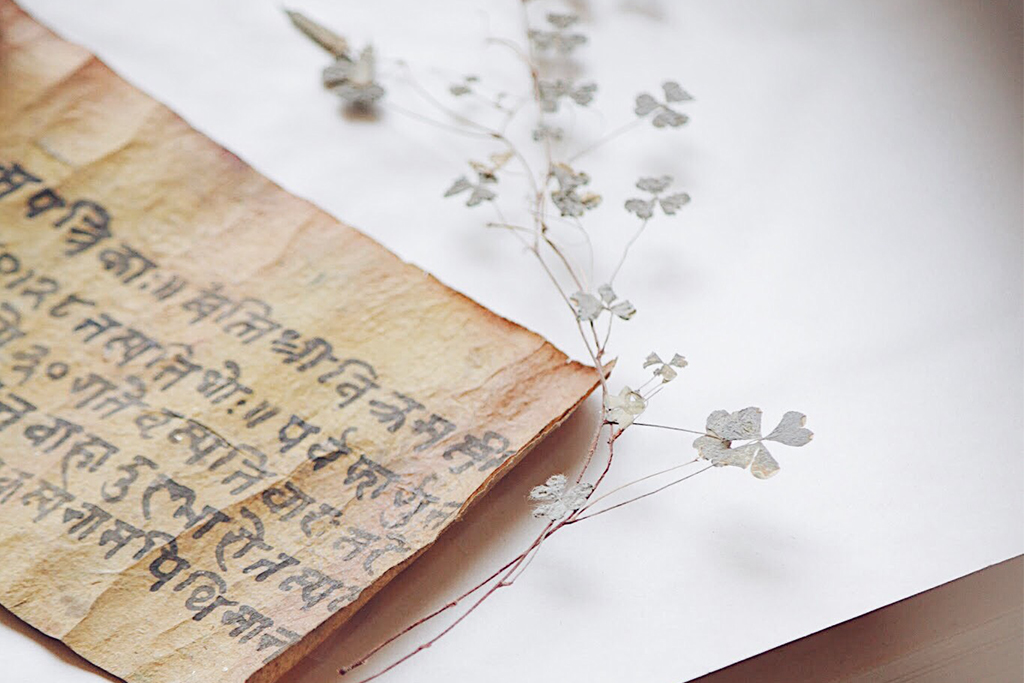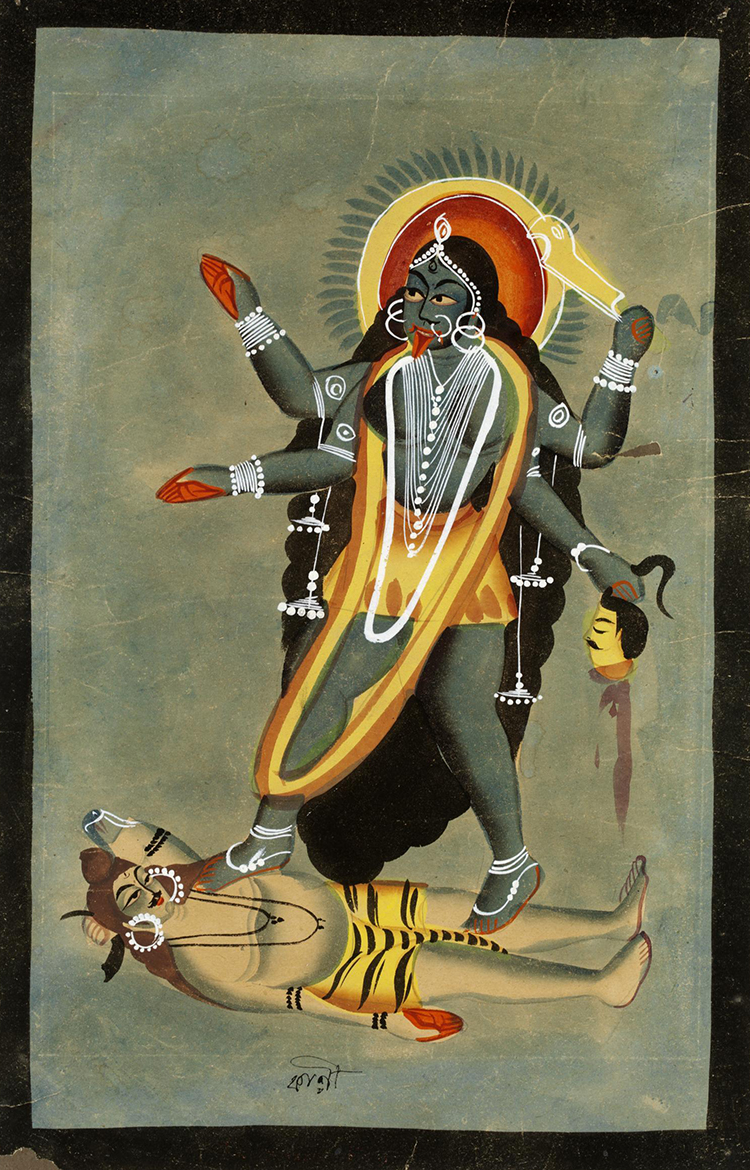



One of the most terrifying goddesses in the pantheon, Kali is the feminine principle that resides within Shiva. She is the destructive energy that we need to guide us out of our complacency and our obsession with the material world

Kali. Opaque watercolour on paper. Chamba, ca. 1710. © Victoria and Albert Museum, London.
Growing up in India we were always warned of the dark and mysterious goddess—Kali. Stories of this apocalyptic goddess centred around death and destruction, her sinister black tongue exposed to the world, fearless in her stultifying anti-beauty (not ugly). From a very western narrative of good vs. evil, it was easier to understand her as a destroyer who sprang from the angry knitted brows of Kalika in one of the many cosmic dramas of Indian mythology. Described in one book as “the gruesome Kali, emaciated and wearing only a tiger skin and a garland of human heads…Kali’s sunken reddish eyes and gaping mouth with great lolling tongue roaring to the skies, she filled the demons with horror.” Stories of her violent massacres of asuras were so vividly macabre that generations of men and women consigned her to the position of the ‘dark goddess’ in the pantheon of tamer Indian gods and goddesses. It was impossible not to be afraid of Kali who carried the khatvanga, the skull-topped staff associated with tribal shamans.
But in tribal folklore, the bedrock of most divine figures, the simplistic narrative of good vs. evil is superfluous and transcends the black and white moral paradigm of most religious theologies. It is in the Atharva Veda (a collection of hymns and mantras published between 1200 BCE and 1000 BCE) that her name first appears. But here her manifestation is that of a fierce black tongue, one of seven belonging to Agni, the god of fire. It is only after 400 years that Kali is described as being a warrior goddess when she appears as one in the Devimahatmya as the savage manifestation of Durga.
Kali’s rage and warring with the demons is symbolic of the fight against our inner demons and a quest to invoke our higher selves. The demons are our own ego, pride, inertia and indiscipline that hampers our spiritual growth. Kali is our primordial mother, our divine guide who constantly rattles us, shaking us out of our complacency and our obsession with the material world. Each severed head that makes up the garland around her head is symbolic of a fear that has been conquered for a higher purpose of self-discovery and self-perfection. And all this to reach a state of bliss, our true natural state. Contemplation on Kali is a contemplation on the annihilation of fear.
Kali and Shiva are inextricably associated. She is the feminine force that lives within Shiva. She is Shakti to the Shiva energy, the intertwining of the cosmic masculine and feminine is seen as the fire of the coiled serpent energy – Kundalini Shakti lying dormant in the base of our spine.

Kali, also understood to be derived from Kala or time, has a multiplicity of manifestations and changes like the seasons. While Shiva the cosmic male principle transcends time and is change-less, Kali is Shakti, the female principle that animates existence, and her infinite forms march with time. Kali is Time. Shiva is Space. And when they come together, they create the path for higher consciousness.
Krishna as Kali, and Shiva. Opaque watercolour on paper. Kolkata, ca. 1885. © Victoria and Albert Museum, London.Images of Kali and Shiva dancing with wild abandon are found throughout India especially in West Bengal. Bengali poetry has vivid imagery of Shiva and Kali dwelling in cremation grounds, immersed in yogic practices and competing fiercely in the tandawa, the dance of destruction. In fact, Shiva’s wife Parvati, the demure feminine energy is seen as a frightened bystander as the two forces of nature are engaged in dramatic exchanges of destruction.
The mad dancing of these two fierce energies is symbolic of the creation and destruction of our egoic selves that is amply represented in the very life and death of all that is around us, in the forever birthing and decaying of the vast cosmos. So, it is said that when the passive Parvati neutralizes his destructive tendencies, Kali steps in to provoke him. And when they combine, Shiva and Kali are the firebrands, the energies within us, that have transformative powers towards our own higher consciousness. The dance of destruction is the release that leads to freedom, which in spiritual terms is mukti or liberation, emancipation and enlightenment.
Kali, also understood to be derived from Kala or time, has a multiplicity of manifestations and changes like the seasons. While Shiva the cosmic male principle transcends time and is change-less, Kali is Shakti, the female principle that animates existence, and her infinite forms march with time. Kali is Time. Shiva is Space. And when they come together, they create the path for higher consciousness.
But as scholar David Kinsley states, “it is never Kali who tames Siva, but Siva who must calm Kali”. In the great saga of the yagna performed by King Daksha, when Kali reveals the full might of her ferocity—dark, terrifying, beautiful and naked, Shiva lays down on the ground in savasana, the yogic death pose, and pleads with Kali to place her lotus-feet on his chest—an act of total love and surrender. Kali was Shiva’s ultimate spiritual provocateur. She can be yours too.
In the forest of Time
Upon the beauteous tree of the world
Hovers Kali Shakti, the divine humming bee
Deep blue in hue, eyes spitting fire.
The six legs of this bee-
so said the sages of yore-
are the six paths to liberation.
She is the embodiment of love
The source also of pain—
bestowing, withdrawing
are her double deeds.
Life is meaningful
if this truth be seen.
Subramania Bharati from The Mystique of MahaKali
Cover Image: Kali. Opaque watercolour on paper. Chamba, ca. 1710. © Victoria and Albert Museum, London.